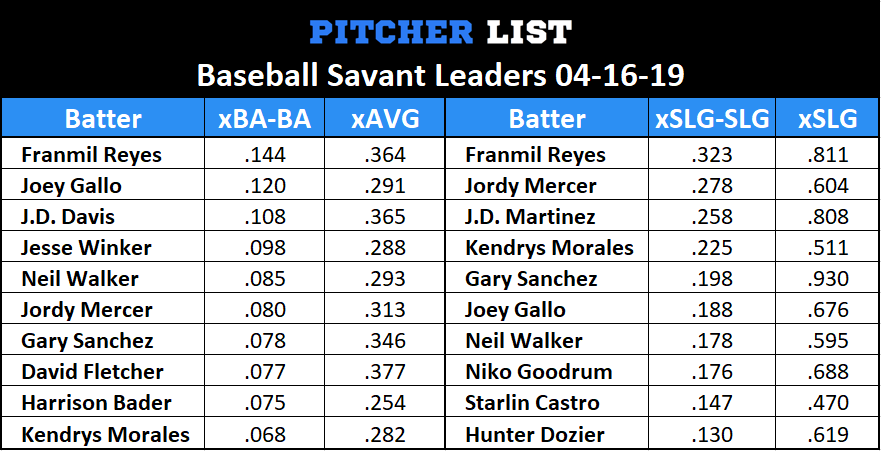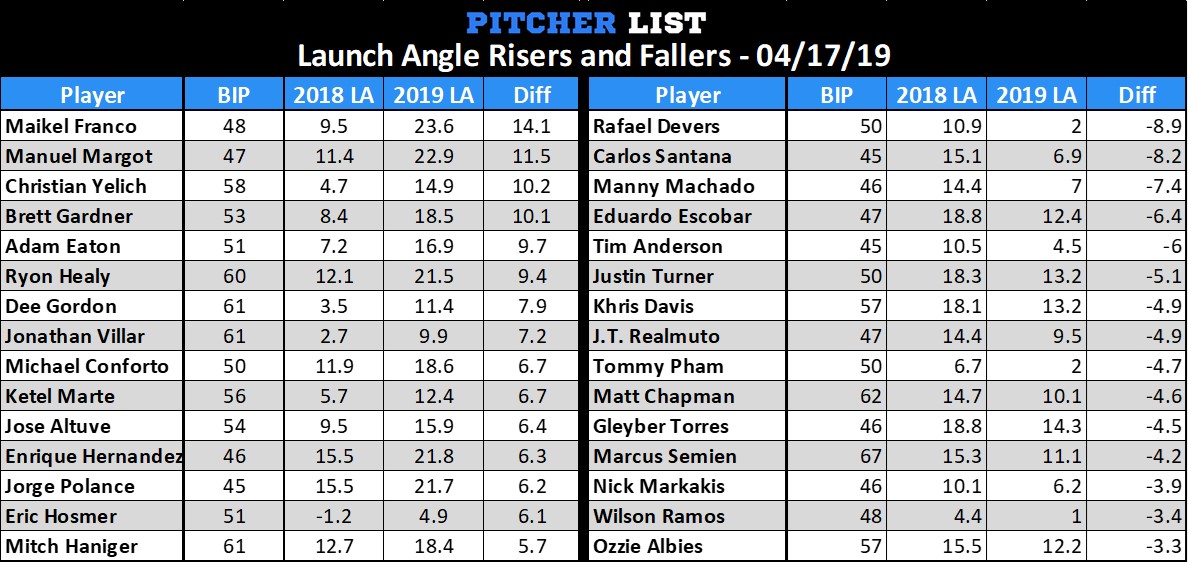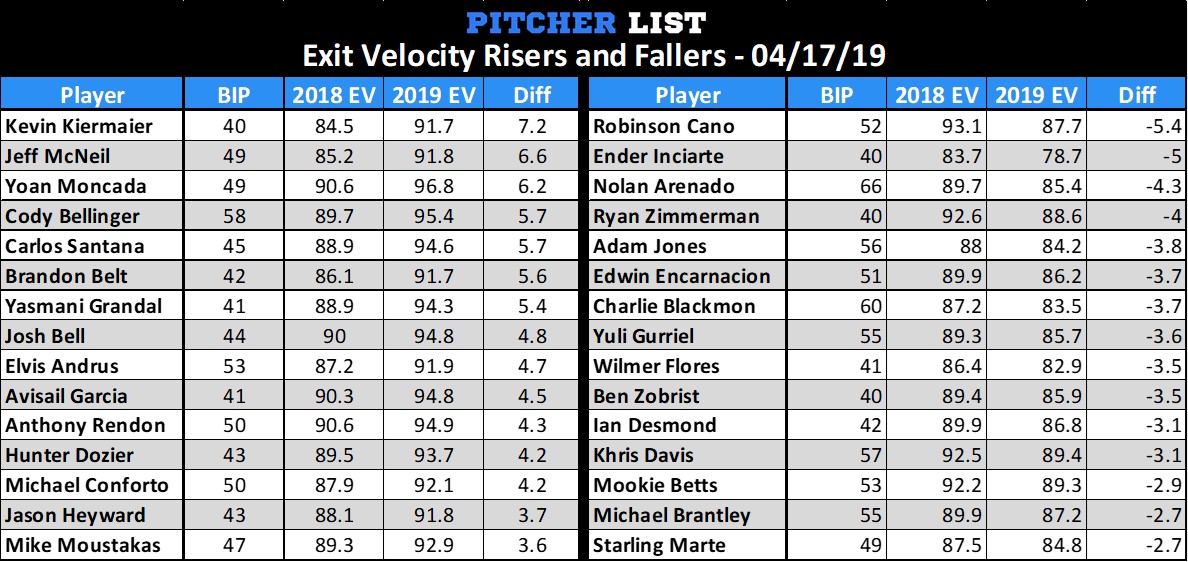We’re officially past mid-April and I’ve got great news for those of us who have been shamelessly using Statcast metrics like exit velocity and launch angles to identify our breakouts thus far (who knew Ryan Cordell wouldn’t have stayed atop the average distance leaderboard after March 28?): Things are finally starting to stabilize! That means we can start having some semblance of confidence in trends we’re seeing for certain players. Below shows the stabilization trends of exit velocity, launch angle, and hit distance over the number of balls in play a batter hits, denoted by the red dotted line that runs parallel to the X-axis. The best way to interpret “stability” in this sense is the sample size at which any random sample has a high correlation to another random sample of the same size.
In layman’s terms: A batter’s average exit velocity from his first 40 balls in play should be statistically related to a 40-BIP sample size from later in the season. That doesn’t mean the batter will have the same average exit velocity all season, but it does mean that we can have more confidence in what we’re seeing at this point in the season than we were able to see before, when randomness played a larger factor. (This is an oversimplification for sure. For a more in-depth description of samples sizes, refer to this extensive work by a guy named Pizza Cutter.)
Now that a good chunk of batters has had greater 40 balls in play, we may be able to gain some insights on who’s rising and who’s falling this season based on average exit velocity and average launch angle. Below I’ve laid out the top 15 risers and fallers for both metrics compared with their 2018 season-long performances, so let’s try to identify some potential acquisition targets based on this newly “stable” data.
But first, let’s start with the expected stats disparity leaders, which will be updated every week. As a reminder, there are qualifiers for this list: a .250 xAVG and a .450 xSLG. To clarify, this list does not mean we expect Jordy Mercer to outslug Mike Trout. Rather, it means that Mercer’s batted ball profile up to this point supports a .604 SLG% rather than his current .278. In this way, we hope to identify potential breakouts, like Niko Goodrum, who Nick Gerli profiled earlier this week.
Now, on to the trends:
Launch Angle Risers and Fallers
UP⇑ Maikel Franco (3B, Philadelphia Phillies) – Franco’s already get six homers on the year and has an OPS over 1.000. Contact skills have never been an issue for the 26-year-old, but this season he’s managed to get his swinging strikes down to 6.4% and is walking in 17% of plate appearances (batting 8th in the order doesn’t hurt there). Franco’s always been a guy who could be more interesting with some lift on the ball, and so far he’s managed to increase his fly ball rate from 33% to 52%. I’m buying here.
DOWN⇓ Rafael Devers (3B, Boston Red Sox) – Another promising young third baseman with contact skills, Devers’ performance so far has been pretty discouraging. He’s yet to hit a long ball after two plus weeks, and his expected slugging percentage is just .327. He’s still hitting the ball hard (90 mph), but it doesn’t matter much with 60% of his balls in play going into the infield grass. He’s got the talent to be a top-50 hitter for sure, but I’m not sure he cracks the top 100 this year.
UP⇑ Manuel Margot (OF, San Diego Padres) – The Padres have a crowded outfield this year, with Margot, Franmil Reyes, Wil Myers, and Hunter Renfroe all competing for at-bats. Margot’s staked his claim so far, slugging .500 with seven extra base hits across 56 plate appearances. Still, he’s not walking at all, and his LA/exit velocity combo of 22.9 and 86.9 only yield an expected batting average of .173. There doesn’t seem to be an imminent breakout on the horizon.
DOWN⇓ Carlos Santana (1B, Cleveland Indians) – For the most part, Santana’s been who he’s always been: taking tons of walks, making good contact, and rocking a solid OPB. The only concern here is that his fly balls have plummeted from 43.7% to 20%. While fly ball/ground ball data hasn’t quite stabilized yet (that usually happens around 80 balls in play), there’s reason to be concerned about Santana’s power numbers. His 95 mph exit velocity ranks in the top 4% of the league, so I’m not really worried yet. He may be a prime buy-low candidate if he can lift the ball closer to his career numbers.
UP⇑ Christian Yelich (OF, Milwaukee Brewers) – There’s not much to say about Yelich that his 2018 NL MVP season and 2019 MVP season numbers don’t already say (that’s right, I’m calling it). With his launch angle lift so far this year, he’s cut his career ground ball/fly ball ratio in half this year to nearly 1-for-1. Lest you had any worry about regression, he’s obviously here to stay.
DOWN⇓ Justin Turner (3B, Los Angeles Dodgers) – One of the poster boys of the fly ball revolution from three seasons ago is struggling to get off the ground, with just two extra base hits in 75 plate appearances. While he may not hit the heights of 2016 again, his profile is very similar to 2015, when he had an OPS of .861.
UP⇑ Ketel Marte (SS, Arizona Diamondbacks) – Marte’s been a popular middle infield breakout candidate for several seasons in a row. He’s already got four homers and two stolen bases on the year after a combined 20 HR+SB last season. The downside is he’s striking out more than usual (17.1%) and has forgotten how to take a walk (2.9% BB%). A career .300 BABIP hitter, his batting average on balls in play this year is just .231. While he’s got the speed to run out ground balls, it’s much harder to run out a fly and I’m concerned his average could take a hit with the launch angle boost.
DOWN⇓ J.T. Realmuto (C, Philadelphia Phillies) – Realmuto’s owners have to be feeling pretty meh so far on their fifth round draft pick. He’s hitting way more ground balls than usual and has a pedestrian .158 ISO. Still, he’s hitting the ball as hard as last year and his expected slugging is a solid .460. I expect a turnaround any day.
UP⇑ Eric Hosmer (1B, San Diego Padres) – Hosmer’s average launch angle of -1.2 last season was the second lowest ever of the Statcast era. It’s could to see him get it off the ground some, but his expected stats still leave a lot to be desired (xBA: .263, xSLG: .393). He may be a little better than last year but he’s still not too exciting at this point in his career.
DOWN⇓ Khris Davis (OF, Oakland Athletics) – Davis is only slugging .689 with 10 homers. Who cares about launch angle anyway?
Exit Velocity Risers and Fallers
UP⇑ Kevin Kiermaier (OF, Tampa Bay Rays) – If Kiermaier is still available in your league somehow, I’m grabbing him. He was disappointing last season before missing most of the year with an injury, but he’s showing some great power this year. His expected slugging of .486 shows his actual .564 isn’t too luck-based, and he’s hitting more than half his balls more than 95 mph. With some stolen bases thrown in — he had 65 from 2015-18 — he’s got top-30 outfielder potential.
DOWN⇓ Robinson Cano (2B, New York Mets) – Cano’s been a major disappointment so far in his stint with the Mets. His hard hit rate is from 51.7% to a bleh 32.7%, and he’s whiffing at a career-worst 12.2% swinging strike rate. At 36 years old, this could be the beginning of the aging downturn for Cano.
UP⇑ Jeff McNeil (3B, New York Mets) – Turns out, McNeil may be the Met with second-base eligibility to own this season. He was lights out in a short season last year, posting an .852 OPS in a little less than half a season. He’s showing that was no fluke, with a 1.000+ OPS and an expected .347 batting average ranking among the top 6% of the league. He won’t hit for tons of power, but the bat skills and some sneaky speed make him plenty useful.
DOWN⇓ Ender Inciarte (OF, Atlanta Braves) – Inciarte’s never been a scary hitter and he’s only getting less so. If it sticks, his average exit velocity will be in the bottom 1% of the league. He’s currently slashing just .173/.259/.288. Unless you’re dying-of-thirst desperate for stolen bases, Inciarte should be considered droppable in 12-teamers.
UP⇑ Yoan Moncada (3B, Chicago White Sox) – We appear to be witnessing a Moncada breakout, with his current average exit velocity ranking in the top 1% of the league. He’s smashing every type of pitch, with his EV for fastballs, breaking balls, and offspeed pitches each above 95 mph. He’s also barreling 20% of his batted balls, while shrinking his strikeout rate from an ugly 33% to a usable 24%. If someone in your league thinks they’re being sneaky and selling Moncada high, I’m buying that all day.
DOWN⇓ Nolan Arenado (3B, Colorado Rockies) – Arenado was a cause for concern in the preseason, and his dip in average exit velocity combined with his very-human performance thus far in 2019 only further than concern. He’s never been a Statcast darling, but his 85 mph average exit velocity doesn’t bode well if you’re hoping for a return to a 40-homer season.
UP⇑ Josh Bell (1B, Pittsburgh Pirates) – Bell’s not only hitting the ball at a top 4% exit velocity, he is finally getting his ground balls under control, dropping from 50% to 40%. He’s hitting more than 50% of his batted balls harder than 95 mph, and his expected slugging (.642) and wOBA (.426) are both top 10% in the league. He’s pulling the ball more, which may support his boosted 19% HR/FB%. Bell was a huge disappointment in 2018, but I like some breakout potential here.
DOWN⇓ Charlie Blackmon (OF, Colorado Rockies) – Blackmon is still searching for his first homer this year, and the rest of his game has been pretty atrocious too, triple slashing just .219/.266/.301. There’s no word of an injury, but I’ll be keeping an eye out for an explanation. He’s never been a huge Statcast darling so I expect him to get things turned around and be mostly who we expected him to be, but 2017’s 37 home run season feels like it’s a long way away.
UP⇑ Hunter Dozier (3B, Kansas City Royals) – Dozier has been a popular pickup after a four home run week, and it’s easy to see what there’s some excitement with his Statcast data backing a possible breakout. Not only is he crushing the ball, but he’s taking walks (11.3%) and has considerably reduced his strikeout rate by 10% (17.7%). The jury’s still out on whether he can hit breaking balls (.239 wOBA in 2018) and lefties (.276 wOBA in 2018), but I’m taking a chance on Dozier in every league he’s available.
DOWN⇓ Khris Davis (OF, Oakland Athletics) – ¯\\_(ツ)_/¯
https://gfycat.com/cookedopenayeaye
(Photo by Kyle Ross/Icon Sportswire)





fun article, perfectly balanced with fun tid bits and interesting stats.
i read that piece on arenado but that was after i had already drafted him. but glaringly that was not my only mistake, i picked up blackmon in the following round so you can imagine how shook i must be.
i think i may stick it out with arenado but all the warning signs, advanced metrics, and gut instinct are telling me to find a one way ticket for ole chuck nazty. who do you think is a fair and valuable target? i have a hole in the 2B and was thinking merrifield could be a reasonable piece. perhaps even albies. i have considered sale as well but with his last start, that opportunity may have left the station.
any thoughts/ideas on how to escape this seemingly haunting mistake? (16 team league btw)
Thank you for reading! Honestly I think trading Arenado for Merrifield or Albies would be a bit rash, even despite the concerns. I don’t expect him to plummet into Rafael Devers territory – more like Kris Bryant territory which obviously still has plenty of value. I don’t see any reason to not aim for Altuve. Maybe Jose Ramirez’s owner is panicking. If you’re going to aim for Merrifield/Albies, I’d target the former and try to get another good player thrown in the deal as well. Arenado’s still got plenty of name value and someone out there won’t share your concerns about him.
Not in a million years! Those trades were regarding Charlie Blackmon aka Chuck Nazty. I still have faith in Arenado to perform for another couple years.
After all, that bloated extension has to mean something. But Chuckie has truly got me sweating. Please re-advise on his status and place in the aforementioned trades.